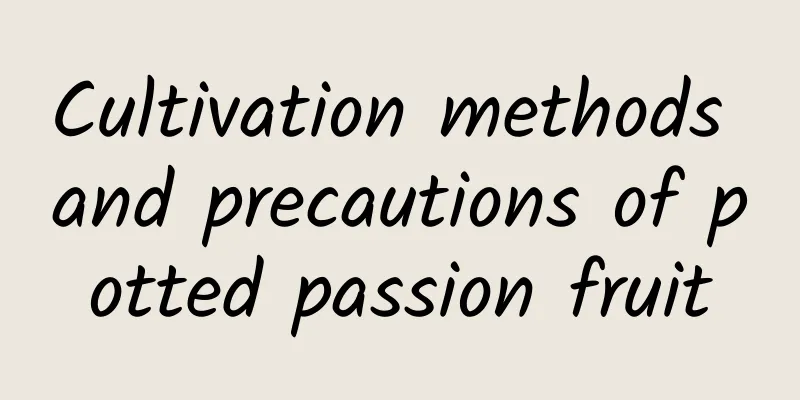Cultivation methods and precautions of potted passion fruit

|
Passion fruit is a fruit tree that is relatively easy to manage and cultivate, but if you want it to have a good harvest, you can't just leave it alone. Although it is not very demanding on the soil, humus-rich soil is better. The flowerpot should be as large as possible, with a diameter of more than 30 cm. Foam boxes are very commonly used containers. How to grow passion fruit in potsPassion fruit needs more sunlight during daily care. The more light the better. It likes high temperatures. In winter, the potted plants should be moved indoors to overwinter. During the period of vigorous growth of passion fruit, it should be irrigated with compound fertilizer water every half a month. Before flowering, use phosphorus and potassium fertilizers. When the main vine of passion fruit grows to 1m in height, cut off the top buds, and pinch off the side branches again when they grow to 1-2cm. 1. Choose potting soil: For potted passion fruit, you should choose a flower pot of moderate size. For seed planting, you can choose a smaller clay pot or a tile pot, and use loose, fertile, breathable and well-drained soil. Passion fruit does not require much soil, garden soil, humus soil, and an appropriate amount of perlite are enough. 2. Lighting: Passion fruit likes plenty of sunlight to promote branch growth and nutrient accumulation. If there is insufficient light, it will grow slowly, have many leggy branches, grow slowly, and even cause the fruit to shrink and fall off. The recommended sunshine time is more than 12 hours, which can promote flower bud formation and flowering. Generally, if the cultivation and management work such as water and fertilizer is done well after planting in early spring, it will continue to bloom and bear fruit in the summer of that year. 3. Temperature: Passion fruit’s temperature requirements are basically the same as those of ordinary tomatoes. It has a wide adaptability and can be grown in both the north and south. If it is grown in the north, it is recommended to overwinter in a greenhouse. In the south, it is recommended to face the arrival of the frost season at an altitude of more than 1,400 meters. 4. Moisture management: Passion fruit is relatively drought-resistant, but if it is too dry, it still needs irrigation, because the soil is too dry, which will affect the development of vines and fruits. In severe cases, the branches will wither, the fruits will not develop and will fall. However, during the rainy season, attention should be paid to drainage. Matters Needing Attention in Caring for Potted Passion FruitWhen caring for potted passion fruit, you should pay attention to diseases and pests, which mainly include seedling damping-off disease, mosaic disease, blight, stem base rot, fruit fly, mites, scale insects, etc. For disease prevention and control, Bordeaux mixture or Ridomil, Antibacterial, Benomyl and other sprays are generally used. For pest control, Agriland liquid, Chlorpyrifos liquid, DDT, Avermectin liquid and other sprays are generally used. |
<<: Honeysuckle planting methods and precautions
>>: The pros and cons of nostalgic and elegant roses
Recommend
When is the best season to plant longan?
Longan planting season and time Longan planting i...
How to grow and water green radish
As a common indoor plant in homes, green ivy is w...
What is mountain soil?
Introduction to Shandi Mountain soil, also known ...
Dandelion's efficacy and effects (medicinal dandelion)
1. Clearing away heat and detoxifying Dandelion h...
How to water the nutrient solution for hydroponic green radish
1. Usage time When you first start hydroponics, d...
What flowers are suitable for growing in Zhanjiang? What are the city flowers and trees?
1. Climate characteristics of Zhanjiang Zhanjiang...
When does the red plum fruit grow?
Introduction to planting red plum Red plum is nat...
How to reproduce the peach
Preparation before breeding This tree is best pro...
This flower is 100 times more beautiful than the Chlorophytum comosum and it does not wither all year round. Even the great people are growing it now!
Leafhopper Arrowroot The leaves of the leafhopper...
How to water Qilin in spring
How to water Qilin in spring Qilin is highly drou...
Pick it in spring, and you will have "elm" money all year round, and feel the "chun" taste on your tongue!
Come to the spring toon sprouts, they are delicio...
Why is the lucky tree losing its leaves?
The lucky tree has become a popular choice for ho...
How to propagate crape myrtle
Grafting This method should be carried out betwee...
How to reproduce the dew lily
1. Propagation by seeding Generally speaking, dew...
How to change the soil and pot of camellia
Camellia soil and pot requirements Camellia is a ...









